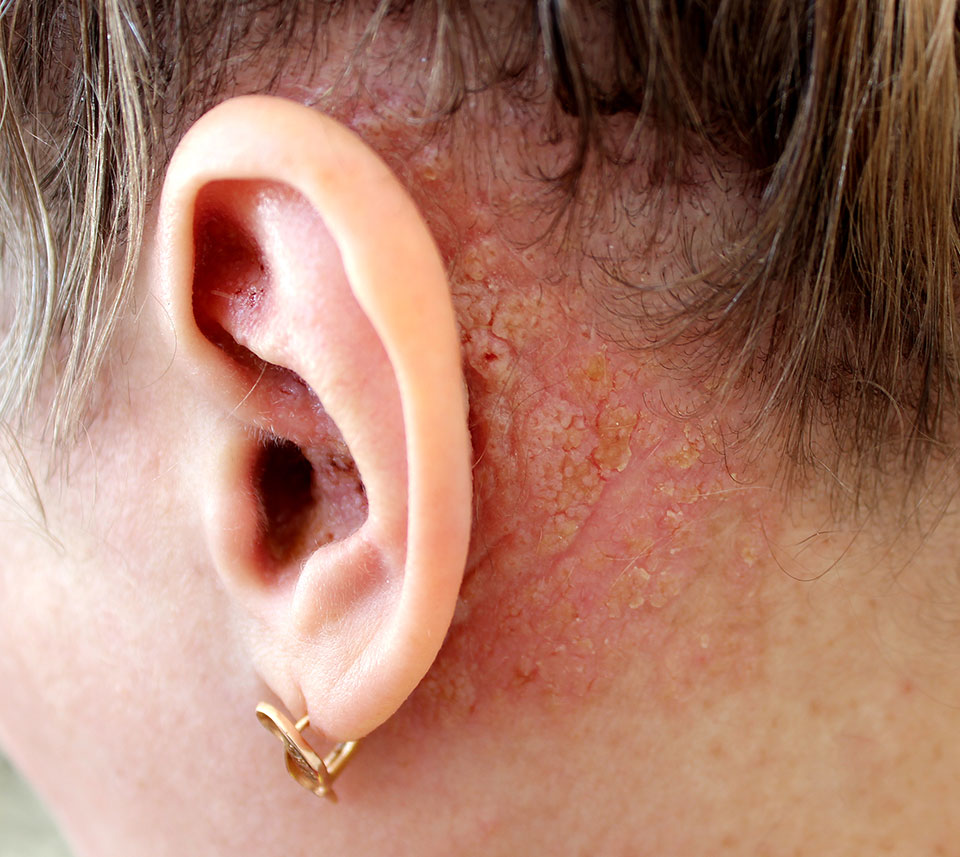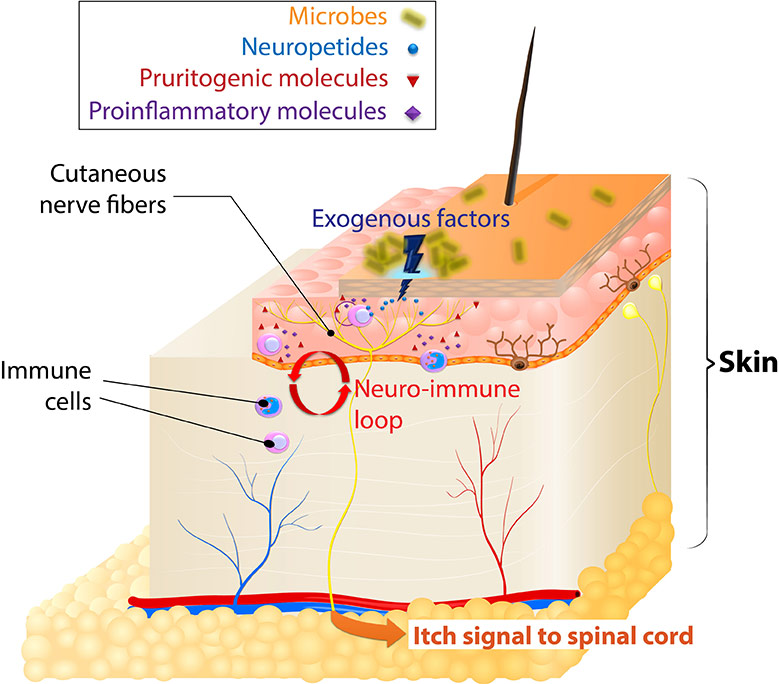THE SCIENCE
We use technology as a tool, not as an end in itself.
At DermaXon we believe that every drug discovery technology should be used to discover new therapeutic strategy or treatment and not to convince private investors or increase stock prices.
We’re passionate about combating unmet treatment needs diseases and disorders. Therefore we constantly challenge ourselves to expand our scientific expertise through collaboration with academic research leaders.
Learn more about our ongoing world-class discovery projects in the following areas:
Ichthyosis
Ichthyosis is a general term used to describe a large and heterogeneous group of cornification disorders that are characterized clinically by persistently dry, thickened, rough and scaly skin.
Currently there is no cure for ichthyosis. Available medicines are aimed only at moisturizing and exfoliating to reduce dryness, scaling, cracking and build-up of skin. Most types of ichthyosis, except for autosomal dominant ichthyosis vulgaris, exhibiting severe scaling are not sufficiently improved with moisturizing or keratolytic creams.

Darier disease
Darier disease, also known as keratosis follicularis, is genetic skin disorder caused by mutations in the ATP2A2 gene encoding a Ca2+ pump and is characterized by greasy and colored (yellow-brown or brown) keratotic papules and plaques in seborrheic areas (central trunk, flexures, scalp, and forehead), palmoplantar pits, and distinctive nail abnormalities. The worldwide prevalence of Darier disease is unknown. The prevalence of Darier disease is estimated to be between 1 in 30,000 to 1 in 100,000 people in USA and Europe. The skin lesions often become infected impacting the quality of life of patients. Treatments include the use of moisturizers and sunscreen or retinoids. Retinoids are effective but induce irritation limiting their use.
More information:
https://www.orpha.net/consor/cgi-bin/OC_Exp.php?Lng=EN&Expert=218
https://ghr.nlm.nih.gov/condition/darier-disease#resources

Pruritus
Pruritus, or itch, is an intense sensation that leads to scratching and is one of the most frequently reported medical symptoms. While transient itch is relatively harmless, chronic itch leads to recurrent scratching that breaks down skin barriers and makes the skin more susceptible to inflammation, infection, and uncontrollable itch sensations. At the cellular level, proteins including histamine and IL-31 are released by immune cells to instruct itch sensing neurons, called pruriceptors, to transmit itch signals. Silencing this crosstalk between immune cells and neurons holds immense potential for treating itch. Interestingly, both immune cells and pruriceptors are highly sensitive to ion fluxes and DermaXon has developed a novel small-molecule able to bind and block specific peripheral ion channels through local administration.
Pain
Pain is a leading health problem in the U.S. with 20% of Americans suffering from chronic pain. Currently, only half of pain suffers receive adequate pain relief, often through the use of drugs with adverse side effects.
Painful stimuli are detected by sensory peripheral nerves which have free nerve endings at bodily surfaces such as skin. These sensory neurons fire action potentials in response to peripheral stimuli and then release neurotransmitters in the spinal cord. This, in turn, activates other neurons that are connected to the brain. The altered processing of these stimuli associated with chronic pain is maintained dynamically by ongoing peripheral input.
It is likely that pain resulting from a variety of causes becomes chronic as a result of the initial reaction to damaged primary afferent fibers and neurons, recruitment of non-involved peripheral nerves, and engagement of central nervous system mechanisms; together, resulting in altered pain processing by neurons in the brain. Abnormal hyperactivity of damaged primary afferent fibers of the peripheral nervous system induces and maintains abnormal hypersensitivity to pain or to normally non-painful stimuli in neuropathic pain caused by cancer treatment, diabetes, and nerve injury.
Additionally, allodynia which is pain resulting from a stimulus that does not normally produce pain, may involve abnormal activity of sensory receptors which detect mechanical stimuli such as touch and pressure. Chronic pain management remains an unmet clinical need with only half of patients receiving adequate pain relief using drugs with adverse central nervous system side effects. DermaXon has identified a novel class of compounds that modulate an undisclosed relevant target to treat peripheral neuropathy.
NEURODEGENERATIVE diseases
Parkinson’s disease
Parkinson’s disease is a chronic and progressive neurodegenerative disease affecting nearly one million people in the US. The cause is unknown, and there is currently no cure, that can reduce loss of dopaminergic neurons. At DermaXon we selectively inhibit RA metabolism in the brain to provide a therapeutic advantage for patients suffering from Parkinson’s disease.
Additional information: https://www.michaeljfox.org/foundation/grant-detail.php?grant_id=1352
Alzheimer’s disease
Brain disease with memory loss due to Dementia and Alzheimer’s illness with the medical icon of an autumn season color tree in the shape of a human head and brain losing leaves as a concept of intelligence decline.
Alzheimer’s disease (AD) is a progressive and ultimately fatal neurodegenerative disease that affects more than five million people in the USA and this figure is expected to jump to 13.8M by 2050 for people age 65 or older. Currently there is no cure for AD. Available medicines are aimed only at temporarily reducing symptoms and slowing down the progression of the disease. While many new compounds have been developed to treat AD, they have not been successful in clinical studies and consequently there is a great need for development of new therapeutic strategies. Recent data show that retinoic acid (RA) the carboxylic acid metabolite of vitamin A, plays an important role in maintaining neuronal plasticity, and learning and memory in human or in transgenic animal model of AD, and support our hypothesis that increasing RA in the brain will improve AD patient outcomes. DermaXon uses inhibition of RA clearance, instead of treatment with RA itself as a novel therapeutic strategy to treat or prevent progression of cognitive impairments associated with AD and to limit the side effects associated with RA treatment. The clearance of RA is predominantly mediated by cytochrome P450 family 26 enzymes (CYP26). DermaXon’s goal is to develop one of our identified selective inhibitors of the different CYP26 isoforms, to increase RA concentration in the brain, and to treat memory impairment associated with AD.
Alzheimer’s Drug Discovery Foundation (ADDF): Alzheimer




